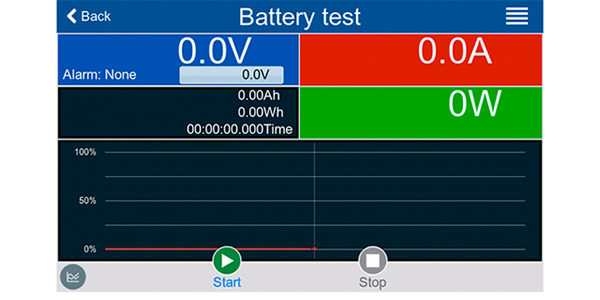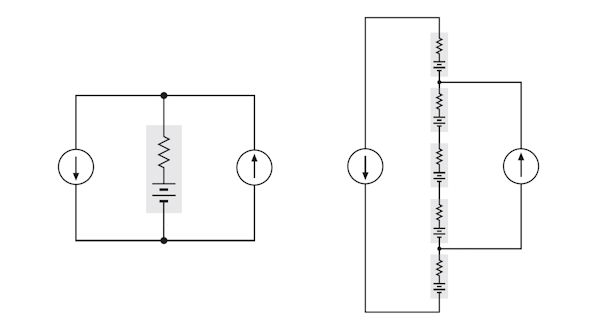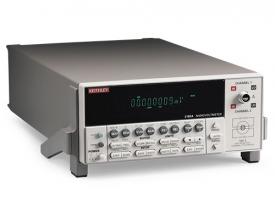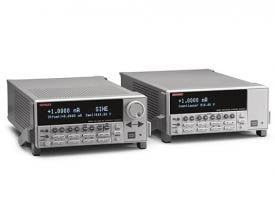Contact us
Live Chat with Tek representatives. Available 6:00 AM - 4:30 PM
Call us at
Available 6:00 AM – 5:00 PM (PST) Business Days
Download
Download Manuals, Datasheets, Software and more:
Feedback
Sử dụng hydro sạch để tận dụng sức mạnh của hóa học
Một loại pin nhiên liệu nằm ở trung tâm của các giải pháp năng lượng sạch hiện đại là pin nhiên liệu hydro. Chúng chuyển hóa năng lượng hóa học từ nhiên liệu thành năng lượng điện thông qua các phản ứng điện hóa. Không giống như các phương pháp sản xuất điện dựa trên đốt cháy thông thường, pin nhiên liệu tạo ra điện với hiệu suất cao hơn và lượng khí thải thấp hơn đáng kể, khiến chúng trở thành yếu tố quan trọng cho các hệ thống năng lượng bền vững.
Tuy nhiên, giống như các nguồn năng lượng truyền thống, các hệ thống pin nhiên liệu cần kiểm tra kỹ lưỡng để đảm bảo rằng chúng cung cấp hiệu suất, độ bền và tuổi thọ cần thiết cho mục đích sử dụng dự kiến. Bằng cách xây dựng một chương trình kiểm tra nghiêm ngặt, bạn có thể đảm bảo rằng các thiết kế của mình đáp ứng các tiêu chuẩn quy định đồng thời tối ưu hóa chất lượng sản phẩm.
Kỹ thuật phát triển pin nhiên liệu
Kiểm tra toàn bộ ngăn xếp pin nhiên liệu
Thị trường pin nhiên liệu hiện đang chứng kiến sự tăng trưởng mạnh mẽ, lên đến 30%, nhờ vào các yếu tố như sáng kiến của chính phủ, ưu đãi kinh tế và các ứng dụng mới. Trong các lĩnh vực như xe tải công nghiệp, xe giao hàng, xe tải đường dài và máy phát điện khẩn cấp, pin nhiên liệu hydro mang lại lợi ích hấp dẫn về chi phí vận hành, hiệu suất và giảm thiểu carbon. Tầm quan trọng của việc đảm bảo tính linh hoạt trong khi vẫn duy trì chi phí vận hành thấp đã tăng lên theo cấp số nhân trong toàn ngành. Một chỉ số phổ biến về hiệu suất của pin là các đường cong phân cực và mật độ công suất của ngăn xếp pin nhiên liệu. Các đường cong này thường được đánh giá dưới các điều kiện hoạt động tối ưu (nhiệt độ, độ ẩm, điện hóa xúc tác và màng trao đổi ion) của một ngăn xếp pin nhiên liệu.
Bằng cách lập trình tải điện tử DC như EA ELR 10000 Series ở các cấu hình dòng điện hoặc điện trở khác nhau, có thể dễ dàng thu được các phép đo này. Các Tải điện tử này là lựa chọn lý tưởng để kiểm tra pin nhiên liệu với công suất đầu vào lên tới 30 kW, có thể mở rộng thành hệ thống lên tới 3,84 MW. Máy tạo dạng sóng tùy ý đi kèm cho phép kiểm tra động, trong khi khả năng tái tạo năng lượng có thể thu hồi tới 96% năng lượng từ pin nhiên liệu vốn bị thất thoát dưới dạng nhiệt.
Lão hóa pin nhiên liệu để tăng độ bền
Việc thực hiện kiểm tra độ bền trên pin nhiên liệu là luôn cần thiết để đảm bảo an toàn và ổn định của sản phẩm; pin nhiên liệu thường là nguồn năng lượng chính trong các ứng dụng. Thử nghiệm độ bền cho pin nhiên liệu có thể là một quá trình kéo dài, dẫn đến chi phí vận hành rất lớn cho một hệ thống pin nhiên liệu 100 kW điển hình. Tiêu chuẩn ô tô yêu cầu 5.000 giờ (~7 tháng) và các ứng dụng lưu trữ cố định yêu cầu hơn 10.000 giờ. Ngay cả khi sử dụng các chu kỳ tiềm năng từng bước và tam giác để rút ngắn thời gian kiểm tra độ bền kéo dài, vẫn có thể xảy ra tổn thất năng lượng đáng kể trong suốt quá trình kiểm tra.
Tải điện tử tái tạo với bộ phát chức năng tích hợp như EA ELR 10000 Series là lý tưởng cho những tình huống này. Công nghệ tái tạo thu hồi tới 96% năng lượng chìm trong quá trình hoạt động mà nếu không sẽ bị mất dưới dạng nhiệt. Một máy tạo chức năng tích hợp cho phép các cấu hình kiểm tra tăng tốc (như dạng sóng bước hoặc sóng tam giác) đồng thời cho phép đo năng lượng tích lũy thông qua chức năng kiểm tra phóng điện.
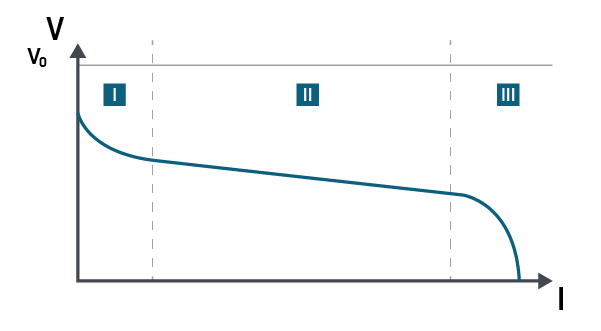
I: Tế bào cho thấy sự giảm điện áp phi tuyến tính khi dòng điện tăng. II: Điện trở Ohmic chiếm ưu thế với mối quan hệ dòng điện-điện áp tuyến tính. III: Điện áp giảm theo cấp số nhân khi phản ứng hóa học không còn cung cấp được năng lượng mới.
Tìm hiểu thêm:
Mô phỏng pin nhiên liệu
Khi làm việc với công nghệ pin nhiên liệu, không thể tránh khỏi việc độ tin cậy của các hệ thống điện hóa này trở thành một yếu tố quan trọng. Khả năng mô phỏng các ngăn xếp pin nhiên liệu khi tích hợp với phần còn lại của hệ thống năng lượng có thể giảm thời gian phát triển và cải thiện độ tin cậy của toàn bộ hệ thống.
Bộ nguồn EA PSI 10000 Series có khả năng vận hành bảng UI (hoặc bảng Điện Áp-Dòng) để thay đổi điện áp đầu ra khi dòng điện đo được thay đổi. Điều này cho phép mô phỏng đầu ra của pin nhiên liệu bằng cách mô phỏng đường cong phân cực.
Nguồn cung cấp hai chiều EA mang lại khả năng mô phỏng đầu ra pin nhiên liệu và hấp thụ năng lượng tái tạo từ đầu ra pin nhiên liệu. Điều này cho phép một thiết bị hoặc tủ rack thiết bị thực hiện nhiệm vụ kép cho các hệ thống từ 30 kW đến 3,84 MW.
Hiểu các phép đo đơn bào
Bất kỳ ai tham gia vào việc thiết kế, sản xuất, ứng dụng hoặc sửa chữa pin nhiên liệu hoặc các thiết bị chạy bằng pin nhiên liệu, đều cần dữ liệu tế bào chỉ có sẵn thông qua các phép đo điện trực tiếp. Khi được diễn giải đúng cách, dữ liệu này không chỉ cung cấp sự hiểu biết về cách thức và lý do tại sao pin nhiên liệu hoạt động, mà còn chỉ ra tình trạng của các tế bào đang hoạt động, giúp dự đoán tuổi thọ của chúng, tiết lộ các cơ chế hỏng hóc và cung cấp cái nhìn sâu sắc về sự phù hợp của chúng cho các ứng dụng cụ thể.
Các thiết bị như Nguồn dòng điện AC+DC Keithley 6221, 2182A Nanovoltmeter và Thiết bị đo nguồn 2450 là những công cụ vô giá để thực hiện đặc tính điện chính xác của từng pin nhiên liệu, cần thiết để hiểu các quá trình điện hóa đang diễn ra.



